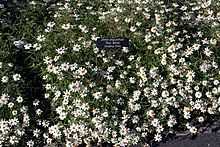Zinnia angustifolia
| Zinnia angustifolia | |
|---|---|
 | |
| 'Zinnia angustifolia 'Star White' in flower and showing habit. | |
| Scientific classification | |
| Kingdom: | Plantae |
| (unranked): | Angiosperms |
| (unranked): | Eudicots |
| (unranked): | Asterids |
| Order: | Asterales |
| Family: | Asteraceae |
| Tribe: | Heliantheae |
| Genus: | Zinnia |
| Species: | Z. angustifolia |
| Binomial name | |
| Zinnia angustifolia Kunth | |
Zinnia angustifolia (Z. linearis) is a herbaceous flowering plant species of zinnia native to northern and western Mexico and natralized in parts of the Southwestern United States. Hybrids with other Zinna species are popular garden plants.[1]
Description
Zinnia angustifolia is an annual or perennial[2] growing up to 50 cm tall. The stems have many branches and the herbage is rough with short hairs.[3] The 2–7 cm × 4–8 mm leaf blades are linear to narrowly elliptic. The heads of flowers have involucres that are mostly hemispheric (shaped like a globe that is cut in half), usually much less than 1 cm high or wide.[4] The flowers have bright orange or sometimes yellow ray corollas,[2] but in cultivated plants, the flowers may be white or a variety of other colors.[5]
Cultivars
This species has many cultivars belonging to three classes:
- The Profusion series (Zinnia angustifolia x elegans): orange, cherry, double cherry, apricot, deep apricot, coral pink, fire or white flowers.
- The Star series: orange, white or gold flowers.
- The Crystal White cultivar: with white flowers.
References
- ↑ Joseph Tychonievich (2013). Plant Breeding for the Home Gardener: How to Create Unique Vegetables and Flowers. Timber Press. pp. 165–. ISBN 978-1-60469-364-5.
- ↑ 2.0 2.1 Paul Schultz Martin (1998). Gentry's Río Mayo Plants: The Tropical Deciduous Forest & Environs of Northwest Mexico. University of Arizona Press. pp. 262–. ISBN 978-0-8165-1726-8.
- ↑ Asa Gray (1895). Field, Forest, and Garden Botany: A Simple Introduction to the Common Plants of the United States East of the 100th Meridian, Both Wild and Cultivated. American book Company. pp. 244–.
- ↑ http://www.efloras.org/florataxon.aspx?flora_id=1&taxon_id=135326
- ↑ Singh, A.K. (1 January 2006). Flower Crops: Cultivation and Management. New India Publishing. pp. 404–. ISBN 978-81-89422-35-6.